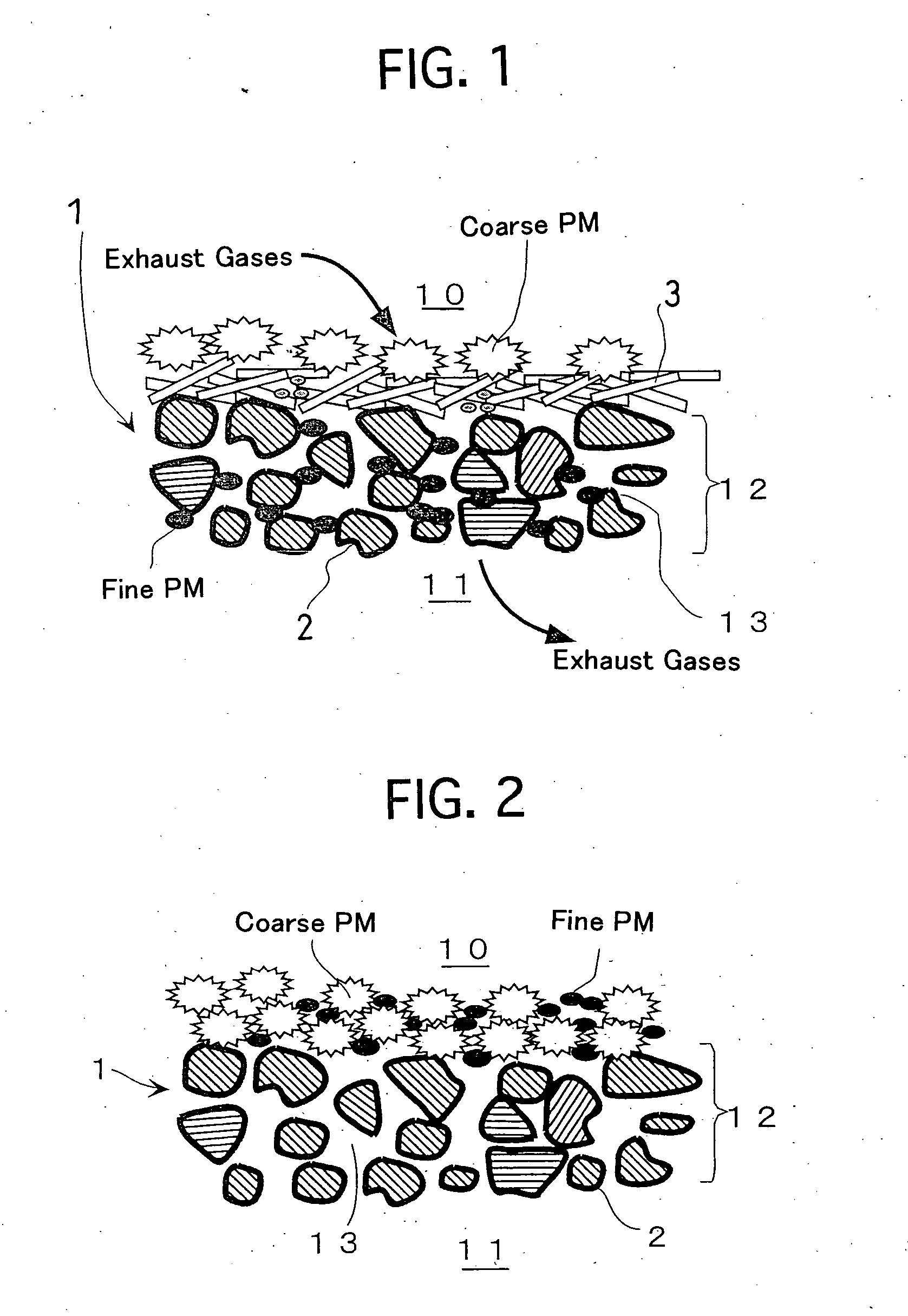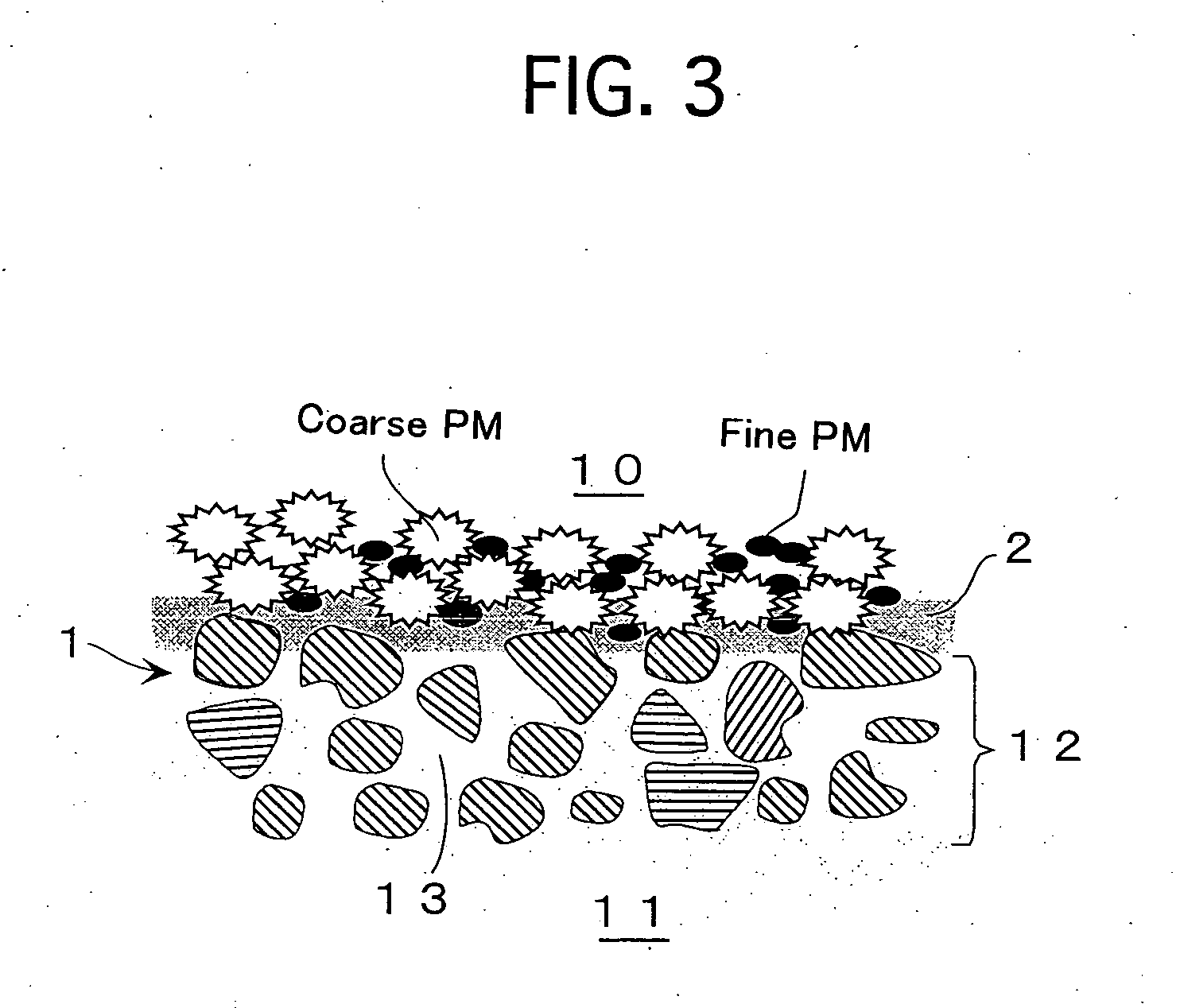Filter catalyst for purifying exhaust gases
a filter catalyst and exhaust gas technology, applied in physical/chemical process catalysts, metal/metal-oxide/metal-hydroxide catalysts, separation processes, etc., can solve the problems of increasing the temperature of burning deposited pms, increasing pressure loss, and advanced technology, etc., to suppress the increase of pressure loss resulting from the deposition of pms, and the oxidizing rate of pms is greatly increased.
- Summary
- Abstract
- Description
- Claims
- Application Information
AI Technical Summary
Benefits of technology
Problems solved by technology
Method used
Image
Examples
examples
The present filter catalyst will be hereinafter described in more detail with reference to specific embodiments and comparative examples.
example no.1
Example No. 1
FIG. 1 illustrates a major cross-sectional view of a filter catalyst for purifying exhaust gases according to Example No. 1 of the present invention. The filter catalyst comprises a honeycomb filter 1, a catalytic layer 2, and a fibrous layer 3. The honeycomb filter 1 comprises inlet cells 10 clogged on the downstream side of the flow of exhaust gases, outlet cells 11 clogged on the upstream side of the flow of exhaust gases, and cellular walls 12 in which a great number of pores 13 are formed. Not only the pores 13 communicate with each other, but also communicate with the inlet cells 10 and the outlet cells 11.
The catalytic layer 2 comprises a support composed of a mixture powder of Al2O3 and CeO2, and Pt loaded on the support. Note that the catalytic layer 2 is formed on both surfaces of the cellular walls 12 and pores 13.
The fibrous layer 3 comprises entangled alumina fibers on which Pt is loaded, and is formed mainly on the surface of the cellular walls 12 of t...
example no.2
Example No. 2
A slurry was prepared which comprised an Al2O3 powder, a TiO2 powder, a ZrO2 powder, an alumina sol and ion-exchanged water, and was subjected to milling so that the solid particles had an average particle diameter of 1 μm or less. Except the thus prepared slurry was used, a coating layer was formed and a catalytic layer 2 was formed by loading Pt on the resulting coating layer in the same manner as Example No. 1.
The resultant honeycomb filter 1 provided with the catalytic layer 2 was measured for the water absorption. The honeycomb filter 1 was absorbed with a predetermined amount of a potassium acetate aqueous solution having a prescribed concentration. After the honeycomb filter 1 was dried, it was calcined to load K on the catalytic layer 2. Note that K was loaded in an amount of 0.2 mol with respect to 1 L of the honeycomb filter 1.
Finally, a fibrous layer 3 was formed in the same manner as Example No. 1. Note that the fibrous layer 3 was formed in an amount o...
PUM
| Property | Measurement | Unit |
|---|---|---|
| Mass | aaaaa | aaaaa |
| Volume | aaaaa | aaaaa |
| Percent by volume | aaaaa | aaaaa |
Abstract
Description
Claims
Application Information
 Login to View More
Login to View More - R&D
- Intellectual Property
- Life Sciences
- Materials
- Tech Scout
- Unparalleled Data Quality
- Higher Quality Content
- 60% Fewer Hallucinations
Browse by: Latest US Patents, China's latest patents, Technical Efficacy Thesaurus, Application Domain, Technology Topic, Popular Technical Reports.
© 2025 PatSnap. All rights reserved.Legal|Privacy policy|Modern Slavery Act Transparency Statement|Sitemap|About US| Contact US: help@patsnap.com



